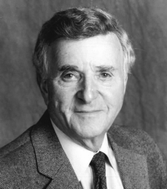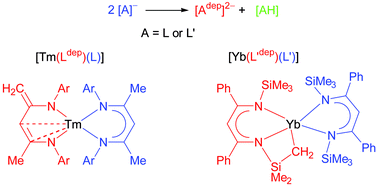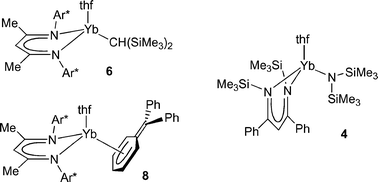Themed collection A collection of papers in memory of Professor Michael Lappert

The influence of Michael Lappert on the chemistry landscape
In memory of Michael F. Lappert, this Editorial introduces a collection of his most highly cited Royal Society of Chemistry publications, curated by members of the Dalton Transactions and ChemComm Editorial Boards.

Dalton Trans., 2014,43, 16553-16556
https://doi.org/10.1039/C4DT90167C
The chemistry of transition-metal carbene complexes and their role as reaction intermediates
New reactions of β-diketiminatolanthanoid complexes: sterically induced self-deprotonation of β-diketiminato ligands
Attempted synthesis of sterically demanding bis- or tris-β-diketiminato complexes of lanthanoids resulted in ligand deprotonation and the formation of complexes containing both a “normal” and a deprotonated ligand; one of these on protonation gave the first cationic β-diketiminato–Ln complex.

Chem. Commun., 2005, 951-953
https://doi.org/10.1039/B416549G
Heteroleptic ytterbium(II) complexes supported by a bulky β-diketiminato ligand
Two new β-diketiminatoytterbium iodides have been used as convenient precursors to the heteroleptic ytterbium(II) amides and hydrocarbyls including N(SiMe3)2 (4), CH(SiMe3)2 (6) and CPh3 (8) derivatives.

Dalton Trans., 2009, 2383-2391
https://doi.org/10.1039/B818969B
Synthesis, structures and reactions of new thermally stable silylenes
Transformation of the bis(trimethylsilyl)methyl into aza-allyl and β-diketinimato ligands; the X-ray structures of [Li{N(R)C(But)CH(R)}]2 and [Zr{N(R)C(But)CHC(Ph)N(R)}Cl3](R = SiMe3)
Transformation of the bis(trimethylsilyl)methyl into a β-diketinimato ligand; the X-ray structure of [Li(L′L′)]2, SnCl(Me)2(L′L′) and SnCl(Me)2(LL), [L′L′= N(R)C(Ph)C(H)C(Ph)NR, LL = N(H)C(Ph)C(H)C(Ph)NH, R = SiMe3)
Synthesis and structural characterisation of the first neutral homoleptic lanthanide metal(III) alkyls: [LnR3][Ln = La or Sm, R = CH(SiMe3)2]
Subvalent Group 4B metal alkyls and amides. Part 9. Germanium and tin alkene analogues, the dimetallenes M2R4[M = Ge or Sn, R = CH(SiMe3)2]: X-ray structures, molecular orbital calculations for M2H4, and trends in the series M2R′4[M = C, Si, Ge, or Sn; R′= R, Ph, C6H2Me3-2,4,6, or C6H3Et2-2,6]
Chemistry, including the X-ray structure, of bis[bis(trimethylsilyl)methylgermanium(II)], R2GeGeR2[R = CH(SiMe3)2], a stable compound having a metal–metal ‘double bond,’ a dimetallene
Three- and four-co-ordinate, hydrocarbon-soluble-aryloxides of scandium, yttrium, and the lanthanoids; X-ray crystal structure of tris(2,6-di-t-butyl-4-methylphenoxo)scandium
Molecular structures of the main group 4 metal(II) bis(trimethylsilyl)-amides M[N(SiMe3)2]2 in the crystal (X-ray) and vapour (gas-phase electron diffraction)
Use of the bis(trimethylsilyl)cyclopentadienyl ligand for stabilising early (f0–f3) lanthanocene chlorides; X-ray structure of [(Pr{η-[C5H3(SiMe3)2]}2Cl)2] and of isoleptic scandium and ytterbium complexes
A novel carbon dioxide complex: synthesis and crystal structure of [Nb(η-C5H4Me)2(CH2SiMe3)(η2-CO2)]
Metallocene derivatives of early transition metals. Part 2. Substituted cyclopentadienyl Group 4A dichloro-metallocene complexes [M(η-C5H4R)2Cl2](M = Zr or Hf; R = Me, Et, Pri, But, or SiMe3), their mono- and di-alkyl derivatives [M(η-C5H4R)2R′X](X = Cl or R′; R′= CH2SiMe3 or CH2CMe3), and their d1 reduction products
Alkyl-bridged complexes of the d- and f-block elements. Part 2. Bis[bis(η-cyclopentadienyl)methylmetal(III)] complexes, and the crystal and molecular structure of the yttrium and ytterbium species
Subvalent Group 4B metal alkyls and amides. Part I. The synthesis and physical properties of kinetically stable bis[bis(trimethysilyl)methyl]-germanium(II), -tin(II), and -lead(II)
Subvalent Group 4B metal alkyls and amides. Part II. The chemistry and properties of bis[bis(trimethylsilyl)methyl]tin(II) and its lead analogue
Standard heats of formation and M–C bond energy terms for some homoleptic transition metal alkyls MRn
Carbene complexes. Part VIII. Chromium(0), iron(0), rhodium(I), iridium(I), nickel(II), palladium(II), platinum(II), and gold(I) mono- and oligo-carbene species from electron-rich olefins
Stable silylmethyl and neopentyl complexes of scandium(III) and yttrium(III)
Silylmethyl and related complexes. Part I. Kinetically stable alkyls of titanium(IV), zirconium(IV), and hafnium(IV)
Metallocene halides. Part I. Synthesis, spectra, and redistribution equilibria of di-π-cyclopentadienyldihalogeno-titanium(IV),-zirconium-(IV), and -hafnium(IV)
Amido-derivatives of metals and metalloids. Part VI. Reactions of titanium(IV), zirconium(IV), and hafnium(IV) amides with protic compounds
385. Amino-derivatives of metals and metalloids. Part II. Aminostannylation of unsaturated substrates, and the infrared spectra and structures of carbamato- and dithiocarbamato-trimethylstannanes and related compounds
103. Co-ordination compounds having carboxylic esters as ligands. Part II. Relative acceptor strengths of some Group III and IV halides
433. Spectra and structure of amide complexes
481. Infrared spectra of boron compounds
308. Stability, solvolysis, and co-ordination reactions of esters of boronic acids and their halogen derivatives
226. Interaction of boron trichloride with optically active alcohols and ethers
About this collection
Michael F. Lappert, one of the giants of 20th century organometallic chemistry, sadly passed away in March 2014.
To honour his memory, and significant contribution to chemistry, members of the Dalton Transactions and ChemComm Editorial Boards have curated this collection of selected publications. Together, these papers highlight his broad interests and ability for pursuing seminal research.
All articles in the collection are free to access until October 2015 and are introduced in a dedicated Editorial written by Professors John Arnold, Penny Brothers, Philip Mountford, Warren Piers, Christine Thomas and Don Tilley.
Do you have a favourite Lappert paper? Would you like to share any experiences or anecdotes about working with Professor Lappert? Join the discussion on the Dalton Transactions blog.